Version control systems based on GIT are popular today. So, not surprisingly, there are many options for accessing GIT, with repository hosting platforms such as GitHub, GitLab, and Bitbucket delivering loads of gratis goodies to a user. This article dives into the nature of the version control system, the distinction between GitHub, GitLab, and Bitbucket, and a detailed comparison of them.
What is a version control system?
A version control system (VCS) is a remote mediator that provides an updated source code to developers and records all the changes made in the project. It’s a set of tools that establishes and facilitates a collaborative environment for developers. A version control system consists of one server that keeps the main data, and a number of local machines that connect to it in order to communicate the data. To understand a version control system better, let’s review its flow and some key terms.
The flow and key terms of a version control system
To start, let's see where the need for a VCS comes from. We can imagine a team that creates an app. A productive workflow requires the team to establish several processes. How to work on the very same files in a synchronized way and get constant updates of new code changes? How to have an accessible log of all modifications that have been done before? And how to experiment with various features without interrupting the main workflow?
This is where a version control system comes in handy.
1. Connecting to a repository. First of all, the team of developers has to connect their local computers to the main server where the project repository is hosted. The repository is the main database on the server where all the changes are recorded and stored. From a repository, changes are later published or implemented into a final product.
2. Pull requests. Being connected allows any developer at any given time to make a pull request from a repository. Initiation of a pull request is equal to an update. With it, a developer demands the latest copy of the code from the server to his or her local machine.
3. Code commit. Besides pulling the data onto their personal machine, anyone can upload their own changes into the shared process. There are two stages involved. The first one is called a commit, which is preparing all the changes on the local computer before sending them to the main server. Basically, committing the changes in the project saves them in the local system.
4. Push request. The second stage is the push request. To make a push request or to push is to publish commits to the repository. With a push, request code updates pass from a local computer to the repository.
5. Using branches. To experiment and progress with the code in a more dynamic way, developers can create branches that are basically duplications in the repository of the whole codebase or part of it. There are two types of branches: a master where all the final changes are stored and a branch as a copy where isolated changes can be made before getting into the master.
6. Code review. Pieces of code in branches can be reviewed by any member of the team. The review refers to the process of code verification after it has been pushed into the repository.
7. Merge. And at long last, when the code verification is complete, branches can be merged together. A merge involves moving a change from one branch to another or to the master branch.
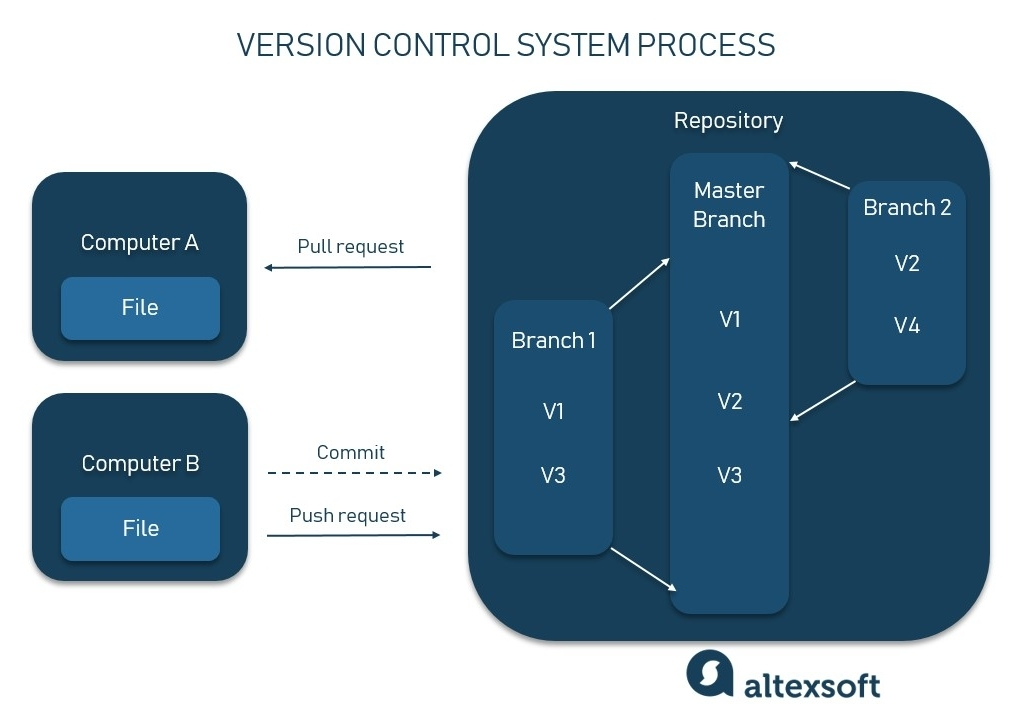
Visualization of the version control system workflow
So, when the team creates an app using a VCS, members can commit their own changes to the project and push them to the repository, review the code in total, pull a fresh update of the code on a local machine, keep track of the previous modifications, work out various features on duplicated branches, and finally merge them with the master. This is VCS in a nutshell.
Briefly about GIT
GIT is one of the version control systems that exist on the market. Besides GIT, there are also systems such as SVN, CVS, Mercurial, and Bazaar. But currently, GIT is far and away the undisputed leader of the pack. According to the Stack Overflow Developer Survey 2021, GIT as a tool prevails among both coders and professional developers. Originally developed in 2005 by Linus Torvalds, who is also known for creating Linux Kernel, it is a free open-source version control system.
In order to access GIT, a developer can use a computer terminal, the most standard option that for obvious reasons does not provide a designed interface. Another way is to install a UI program for GIT like Sourcetree, Git Cola, TortoiseGit, or Fork. And last, there are repository hosting platforms for GIT control systems on the web such as GitHub, GitLab, and Bitbucket, all of which we’ll detail later in this post.
What is GitHub?
GitHub was founded in 2008 by California developers and, in mid-2018, it was acquired by Microsoft. According to the platform’s statistics, as of the beginning of 2022, more than 73 million developers are using the source along with 4 million organizations, and in total there are over 200 million hosted repositories.
The reason GitHub became so popular is at the core of its positioning – social coding. At the very start, the platform allowed collaboration for free on open-source projects. Since then developers from across the globe were attracted to GitHub as the space where they can join the project to gain experience, showcase their own work, get advice from the community or solution to a problem. Very quickly GitHub became not just a reliable and stable VCS but also a valuable and active community of devs.
The social aspect was highlighted even more when GitHub Pages was introduced: a simple way to build a web page on the platform – a triple win for a developer. Having a profile on GitHub presents the dev’s portfolio and skills, indicates that he or she knows VCS and how to collaborate on it, and involves this person into the potential pull of devs to be hunted by HRs.
GitHub features
- Version control system features include basic VCS tools, along with a bunch of instruments that improve in one way or another using those tools. For example, GitHub offers drafts for pull requests, notifications for code owners, protected branches, and reviews between assigned individuals and teams. The platform also provides Codespaces, a GitHub cloud development environment.
- Project management tools facilitate the version control system workflow with task and issue visualization, bug tracker, and Wikis. Roles management is also available on the platform.
- CI/CD and automation on GitHub consist of continuous integration and continuous deployment automation, and such services as GitHub Pages along with GitHub Marketplace. The first one allows the creation of simple web page; the second provides integrations and applications for GitHub users.
- GitHub is well secured with two-factor authentication for logging in, status checks and code scanning for vulnerability elimination, and security alerts for team members.
Best for: majority of development community.
Who won’t benefit from it: projects that need to keep the code out of third-party services.
An additional benefit to the VCS: social network for developers.
Companies using GitHub: Stripe, Etsy, Facebook, Spotify.
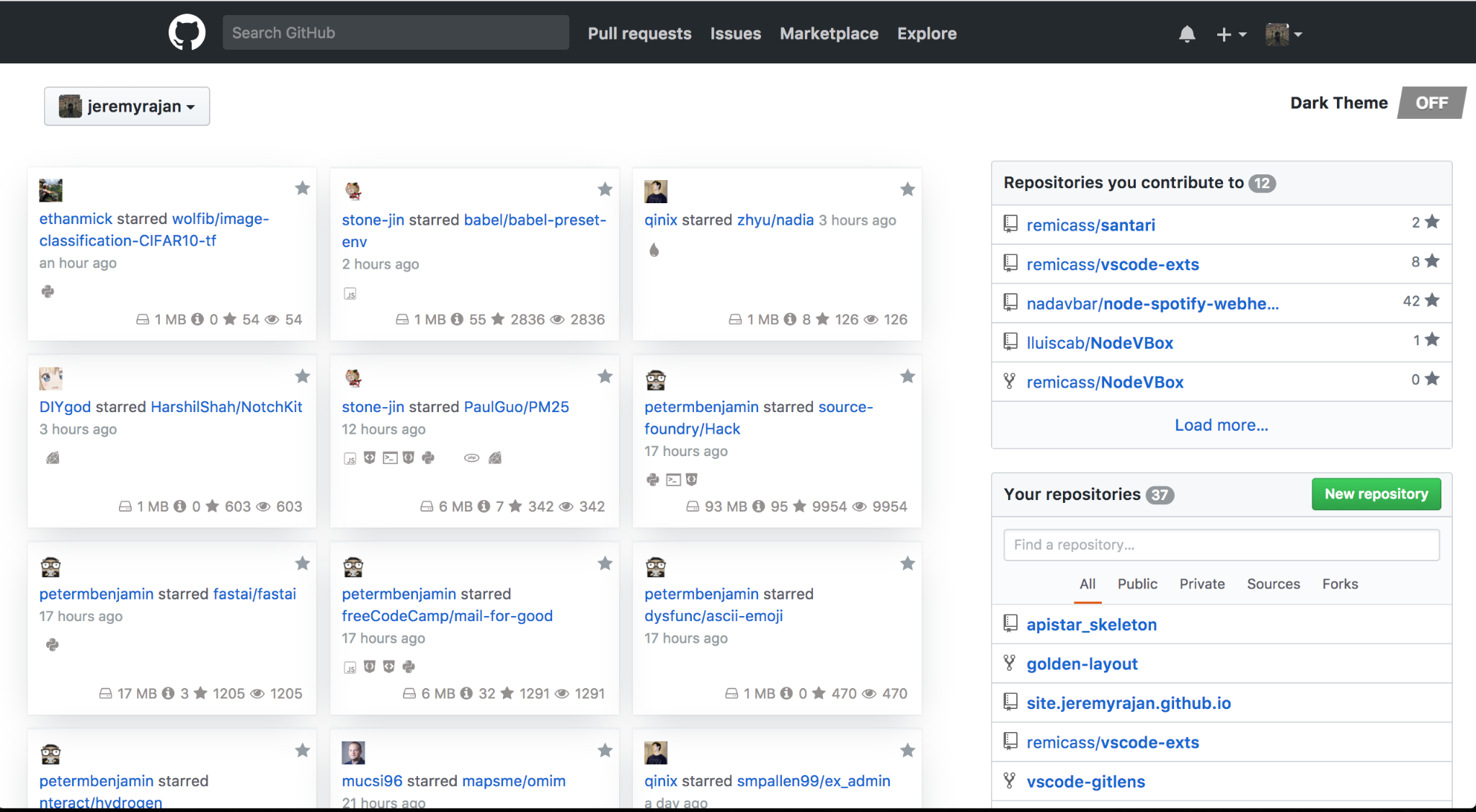 GitHub dashboard
GitHub dashboard

GitHub branches viewer
What is GitLab?
Just like the previous VCS, GitLab is a remote host for repositories. It was created by a team of two developers, one from Ukraine and another from the Netherlands, and put out on the market in 2014. But GitLab does not just store the code and facilitate collaboration, it does much more.
The main distinction between GitLab and other GIT repositories is that it supports a full DevOps cycle. DevOps is an approach to creation in which developers and operations have a constant communication flow. Also, DevOps implies a top level of automation, enabling all the development and application processes to go rapidly between stages. As a result, testing, releasing, and showcasing become much faster.
For the DevOps facilitation, GitLab has also implemented processes of continuous integration, continuous deployment, and continuous delivery in its system. These tools help the building process to run directly from the GIT. There is an article in our blog dedicated to the CI/CD tools that definitely deserves the attention of those who are interested in automation. Summarizing briefly, on GitLab alone development, security, operation, and business are in perfect symbiotic workflow for delivering the final product faster and collaborating in a more seamless environment.
And last but not least, there is one more thing to add about GitLab. The platform itself is open-source with an MIT license and that provides two benefits. First, anyone can follow GitLab development and contribute to the process. This explains why the platform is loaded with features and implements new ones constantly. Second, being open-source, GitLab can be hosted and run on a local system, so private repositories and codes aren’t out there in the hands of third parties.
GitLab features
- GitLab’s version control system includes a wide variety of features. Besides basic version control instruments, there are tools that aim to divide a workflow between a repository and local machines into smaller and more efficiently controlled stages. For example, GitLab offers push request rules, merge request approvals and merge request drafts, and protected branches. Similarly, it provides simple migration from previous GIT providers to GitLab.
- In order to manage projects faster and better, there are planning tools available such as issues, task lists, assignees to projects, and time tracking. Supervision of general business performance is included in the package as well.
- CI/CD automation is the core of GitLab. The VCS workflow is constructed around DevOps with the goal of facilitating and automating continuous integration, continuous deployment, and continuous delivery. GitLab offers automated merge requests when CI/CD succeeds, and DevOps reports point to areas of improvement.
- Regarding security measures, the platform proposes code quality reports, vulnerability management, Infrastructure as Code Security Scanning, Dynamic Application Security Testing, and Dynamic API Security Testing.
Best for: full DevOps cycle implementation.
Who won’t benefit from it: big open-source projects.
An additional benefit to the VCS: open-source code of the GitLab.
Companies using GitHub: IBM, Delta Airlines, NVIDIA, Tor.
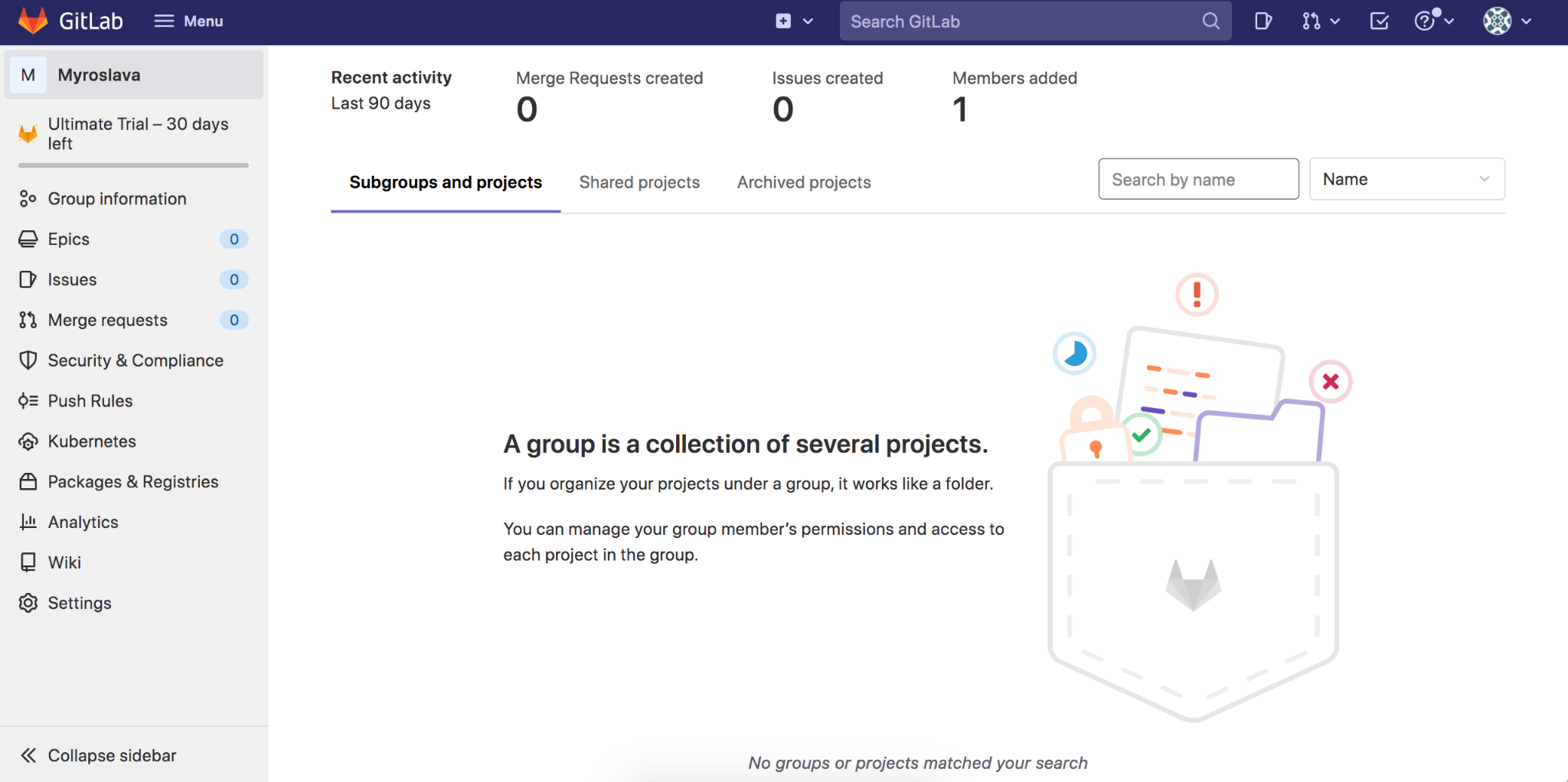
GitLab dashboard of the private account
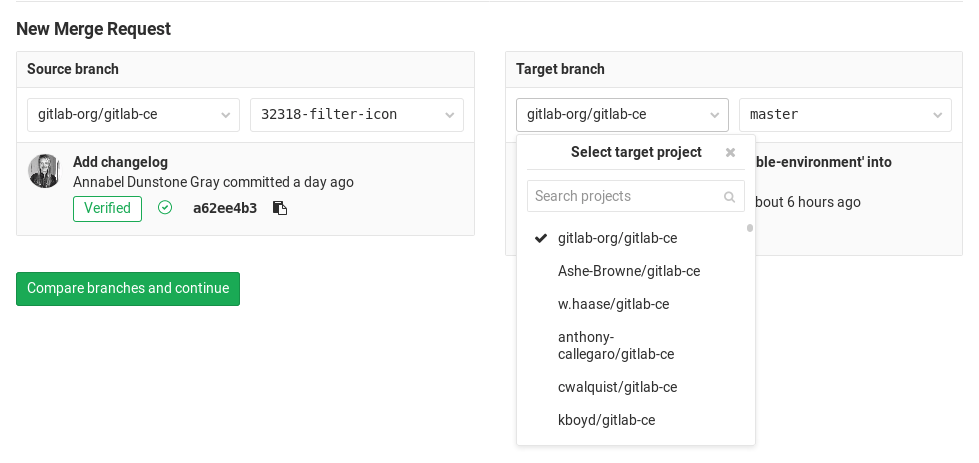
GitLab branches
What is Bitbucket?
Bitbucket is one of today’s three famous GIT version control systems. Originally launched in 2008, in 2010 the service was acquired by Atlassian. Atlassian is quite famous among corporations for organizing tools like Trello, Jira, and Confluence. Not having as many features as GitLab or GitHub, Bitbucket attracts companies with seamless integrations due to its parent company.
Bitbucket became popular on the market because at some point it was the one offering unlimited, free private repositories. The service quickly attracted startups and small businesses that were determined to keep their code to themselves and were looking for new corporate solutions. Currently, other GIT systems also propose private repositories in free plans. But besides that, Bitbucket is free to official nonprofit organizations and charities, and it also offers discount options for students and teachers.
Bitbucket features
- Version control system tools from Bitbucket include all the standard features of any VCS. The main distinction is that this service introduces the project structure of repositories, as it keeps the main focus on integrated tools and their symbiosis.
- Project management is Bitbucket's strong suit. Having native integrations with Jira, Confluence, Trello, Bamboo, and Opsgenie, this version control system flows all the inner processes, even CI/CD deployment, through the mentioned platforms.
- CI/CD automation is provided by Bitbucket in integration with Jira first of all, and it focuses on the integration, deployment, and automate dev to deployment.
- Security procedures include automated vulnerability monitoring, pull request scanning, and a security dashboard with corresponding data.
Best for: corporate-oriented teams.
Who won’t benefit from it: small open-source projects.
An additional benefit to the VCS: native integrations with Jira and Confluence.
Companies using GitHub: PayPal, Klarna, Tesla Motors, Upwork.
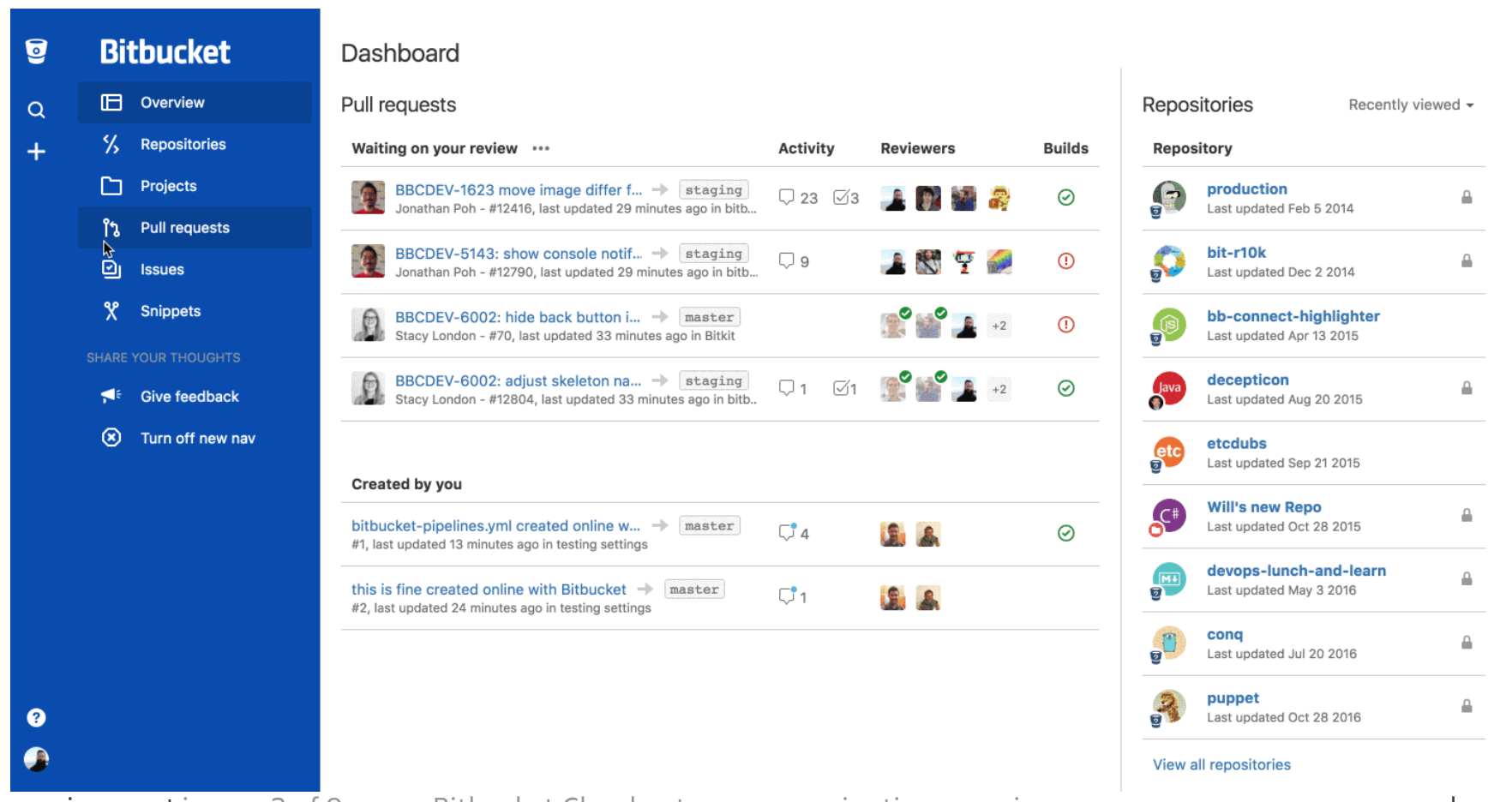 Bitbucket dashboard
Bitbucket dashboard
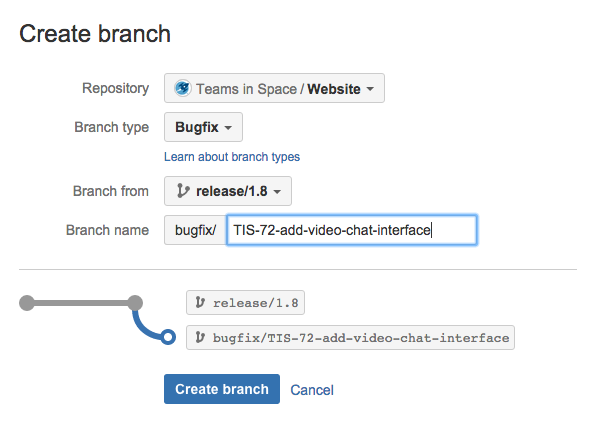
Bitbucket branches
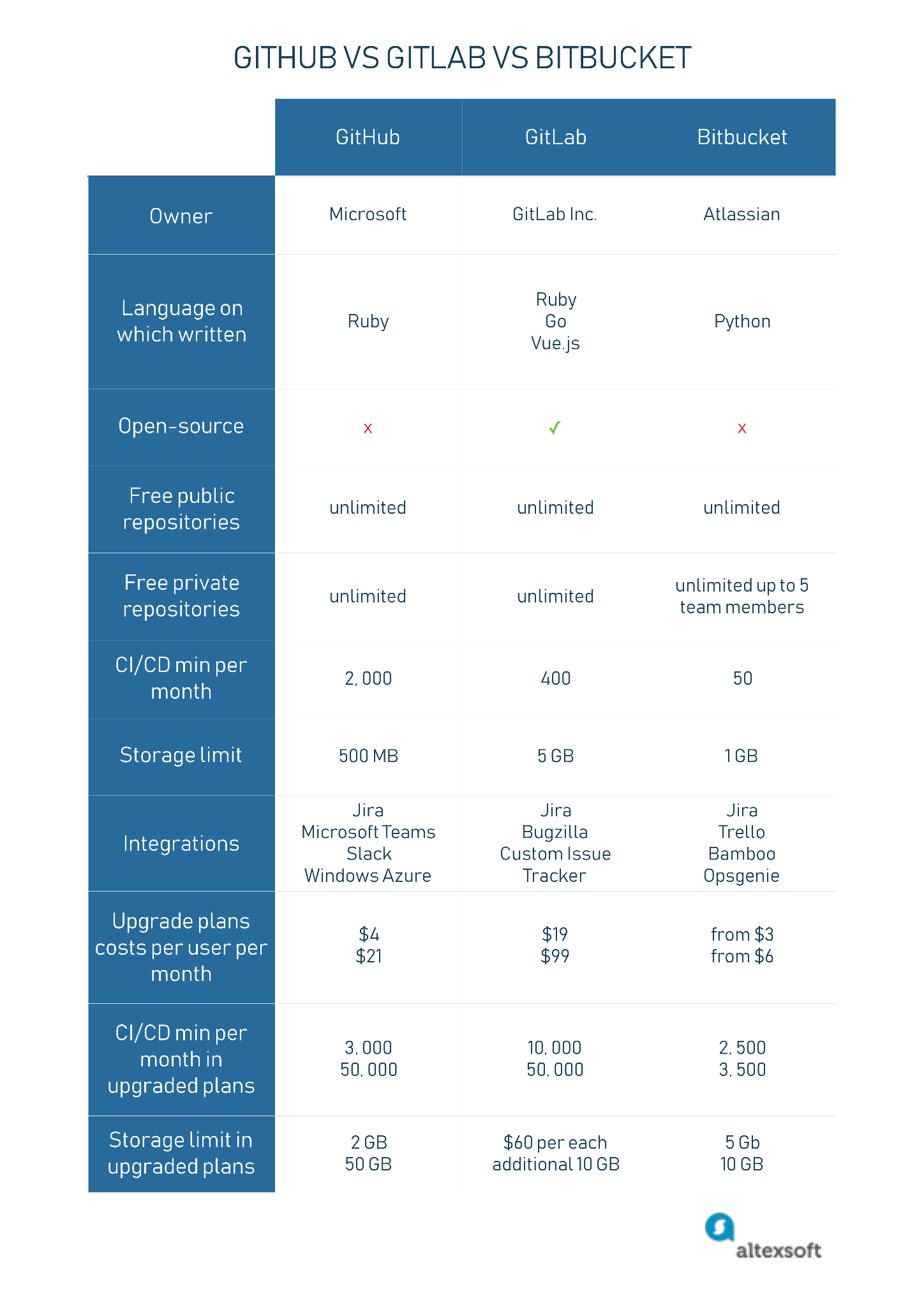
Comparison table of GitGub, GitLab, and Bitbucket that highlights main differences between version control systems
GitHub vs GitLab vs Bitbucket
Generally speaking, all three version control systems do great jobs. But GIT services in recent years have gone far beyond just VCS implementation. From that point of view, let’s dive into the distinctions between GitHub, GitLab, and Bitbucket.
Free and paid features
Currently, the three services propose attractive free features that can satisfy individuals and small projects. But when it comes to a bigger business, upgraded plans are required. And here the choice becomes difficult. If we compare Bitbucket vs Github or GitLab, the first one has lower prices but, as you’d expect, for far fewer features. While GitLab has the highest prices, we can see that the plans are attractive enough to justify the pricing. At the same time, GitHub charges less but offers a range of benefits almost equal to GitLab’s.
Integrated CI/CD and DevOps
As of the beginning of 2022 GitHub, GitLab, and Bitbucket offer continuous integration and continuous deployment as they were repeatedly requested by developers since basically forever. GitHub and Bitbucket perform strategic movement towards DevOps establishment. But still, the leading role is owned by GitLab with its constant focus on DevOps full cycle and built-in CI/CD.
Integrations
Bitbucket is probably the most famous version control system for its integrations as it basically develops in synchronization with corporate workflow tools that natively are implemented into this VCS. But to be fair, GitLab is also well integrated with issue trackers, including Jira. And when it comes to GitHub it has hundreds of applications on its Marketplace.
Open-source
Out of all three version control systems, GitLab is the only open source GIT. We mentioned before that open-source quality might be extremely interesting for companies that want to run VCS locally and keep their code private. But regardless, GitHub still has the most powerful community, and Bitbucket is often selected by businesses. Thus, being open-source is not a key feature, unless it is.
Community
Regarding the community factor, GitHub is for sure the leader. There are almost 50,000 questions with the tag “GitHub” on Stack Overflow. The platform itself is famous as a space where developers can discuss matters, join collaborations, seek experience and expertise. GitLab meanwhile is definitely smaller community-wise, with nearly 15,000 searches by tag on Stack Overflow, but still very popular among coders, being especially captivating because of its constantly updating features and open-source nature. At last, Bitbucket has not acquired a strong community core, only a bit more than 7,000 requests within Stack Overflow’s search. Yet, Bitbucket does have other strong points such as integrations and a corporate-like approach to a workflow.
Learning curve
Regarding the learning curve, all three version control systems are truly similar in their core functionality and thus require about an equal effort to figure them out. The only real consideration is the popularity factor. Due to GitHub’s overwhelming popularity, it has far more learning materials, cases, discussions, and tutorials both on its own website and those dedicated to developing platforms.
How to choose between GitHub, GitLab, and Bitbucket after all is said and done?
As luck would have it, there is no single correct response – just a promise of flexibility. You have to understand your needs and compare them with the given VCS functions. Individuals and companies would certainly have a different approach in choosing the GIT system.
For an individual’s purposes of learning, gaining experience, and presenting results, the community-oriented GIT would fit the best. For small startups that prefer to guard their intellectual property well and collaborate in a company-like environment, the corporate tools of VCS would be handy. And for big projects that require a full development cycle, DevOps are nothing less than precious.
And yet, these examples are not the templates of decisions. If a big corporation prefers to involve collaborators in co-developing new features, the open source format might suit them best. In any case, no one forbids using them all.

